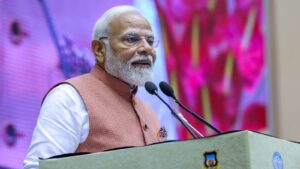Retailers in the US and the European Union (EU) increased their orders for cotton garments from Vietnam instead of China and Bangladesh in 2024. India, too, gained during the period, experiencing a 20 per cent growth year-on-year during the April-December period of the current fiscal.
“Compared to 2022, China’s market share in the US declined by 1 per cent last year, dropping from 21.8 per cent to 20.8 per cent. Each 1 per cent market share translates to approximately ₹6,900 crore worth of business in the US,” said Prabhu Dhamodharan, Convenor of Indian Texpreneurs Federation (ITF).
China’s lost share was distributed among multiple countries, with each competing nation gaining 0.2 per cent to 0.6 per cent from this China Plus One shift. India gained 0.2 per cent market share, bringing its current share to 5.9 per cent, he said.
Texprocil data
According to The Cotton Textiles Export Promotion Council (Texproci), data released by the Ministry of Commerce & Industry show that exports of cotton yarn, fabrics, made-ups and handloom products from India grew by 11.98 per cent in December 2024 over December 2023.
During April-December 2024, Indian cotton yarn, fabrics, made-ups and handloom products registered a growth of 2.82 per cent. The growth of apparel during the first nine months of the current fiscal was 11.5 per cent.
“Bangladesh garment orders have been diverted to India. This has resulted in good demand for domestic yarn and garment exports,” said Anand Popat, a Rajkot-based trader in cotton, yarn and cotton waste.
“Even getting 5-10 per cent of the orders from Bangladesh means a lot. The weakening of the rupee will also help,” said Raichur-based Ramanuj Das Boob, a sourcing agent for multinational and domestic companies.
New challenges for China
Dhamodharan said the US administration has introduced new tariffs (ranging from 0 to 35 per cent) on small parcels from China. This will create challenges for e-platform companies, making small-parcel shipments from China less competitive.
“This will open up big opportunities for India to bet on e-commerce fashion exports,” he said, adding that India is witnessing a surge in inquiries, with apparel exporters experiencing better order visibility from the US.
Indian apparel exporters are witnessing a surge in inquiries and better order visibility, with brands introducing new product categories that were previously not manufactured in India, said the ITF convenor.
“A few Indian companies are drawing up plans for exclusive large-scale capacities to cater to the US market, a positive and much-needed move from India’s perspective to enhance scale and competitiveness in the global market,” said Dhamodharan.
Vietnam turns to US cotton
However, Vietnam has begun to buy more cotton from the US than India. “Indian cotton prices are higher than US rates. Vietnam is buying from Brazil and West Africa too,” said Popat.
“Vietnam is not buying as Intercontinental Exchange (ICE) prices are 66-68 US cents a pound. It also does not impose Customs duty,” said Das Boob, adding that small quantities of yarn have been imported into India.
Currently, cotton benchmark futures are ruling at 67.4 US cents a pound (₹46,375 a candy of 356 kg). In India, exports benchmark cotton Shankar-6 is quoted at ₹53,550 a candy.
“The cotton market is stagnant in India. The Cotton Corporation of India (CCI) has procured 92 lakh bales under the price support programme buying the natural fibre at the minimum support price (₹7,121/quintal for medium staple variety),” the Raichur-based sourcing agent said.
CCI procurement
CCI procurement could top 100 lakh bales but the price level is comfortable for spinning mills, he said, adding that Bharat Tex 2025, India’s largest textile event, will likely help the sector to some extent.
According to the US Department of Agriculture’s World Markets and Trade report, Vietnam’s 2024-25 (August – July) cotton imports and consumption are projected at a record 7.4 million bales (217.7 kg) and expected to surpass the previous year by more than 10 pe rcent. Several factors are expected to drive record demand, including a record pace of garment exports and an increasing pace of foreign-direct investment (FDI), it said.
Rewrite this news article and keep the same structure, information and length.










